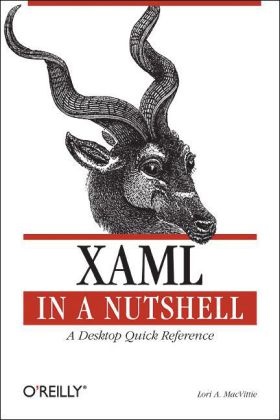Share
Fr. 42.90
Lori A MacVittie, Lori Macvittie, Lori A Macvittie, Lori A. Macvittie
XAML in a Nutshell - A Desktop Quick Reference
English · Paperback / Softback
Shipping usually within 3 to 5 weeks
Description
When Microsoft releases Windows Vista, the new operating system will support applications that employ graphics now used by computer games-clear, stunning and active. The cornerstone for building these new user interfaces is XAML ("Zammel"), the XML-based markup language that works with Windows Presentation Foundation (WPF), Vista's new graphics subsystem.An acronym for Extensible Application Markup Language, XAML offers a wealth of new controls and elements with exciting capabilities, including animation and rendering of 3D graphics. Windows developers are already jazzed by the possibilities of using XAML for fixed and flow format documents like PDF and HTML, 2D and 3D vector-based graphics, form development, animation, audio and video, transparent layering, and a lot more. Many feel that XAML will eliminate the need for multiple file formats or plug-ins (read: Flash), while lowering development costs and reducing time to market.The problem is, most developers don't know XAML. While it is fairly easy to understand, you still need a quick guide to bring you up to speed before Vista's release, and that's where this book's simple, no nonsense approach comes in.XAML in a Nutshell covers everything necessary to design user interfaces and .NET applications that take advantage of WPF. Prerequisites such as Microsoft's new unified build system, MSBuild, and core XAML constructs and syntax-including shortcuts-are all presented with plenty of examples to get you started. The Core XAML Reference section lets you dig even deeper into syntax rules and attributes for all XAML elements with a series of quick-reference chapters. This section divides XAML elements into logical categories of elements, controls, shapes and geometry, layout, animations, and transformations for easy reference.XAML in a Nutshell helps you learn, firsthand, how to use this XML-based markup language to implement the new generation of user interface graphics. As one reviewer noted, "Strong code examples and an efficient, conversational style take the tedium out of learning XAML and make the subject understandable-even interesting."
List of contents
Inhaltsverzeichnis
Chapter 1
Preface
I. Introducing XAML
1. Introducing XAML
The Benefits of XAML
What XAML Is Not
XAML Development Resources
2. Getting Started with XAML
XAML Prerequisites
Defining XAML Applications
Building XAML Applications
XAML Applications and Visual Studio
II. XAML Concepts
3. The Basics of XAML
Core XAML Syntax
Elements
Attributes
Attached Properties
Binding Properties
codebehind
4. Layout and Positioning
StackPanel and DockPanel
Using Width and Alignment
Margins and Padding
Grid
Absolute Positioning
5. Resources
Using Resources
Using Styles
Triggers
6. Storyboards and Animations
Storyboards
Controlling Animations
Animation Using Key Frames
III. Core XAML Reference
7. Elements
8. Controls
Base Control Reference
Common Event Reference
Core Control Reference
9. Shapes and Geometry
10. Layout
11. Animations and Transformations
12. Events
Routing Strategies
Event Argument Reference
Event Reference
IV. Appendixes
A. System.Windows.Controls
B. System.Windows.Documents
C. System.Windows.Shapes
D. System.Windows
E. System.Windows.Media
F. System.Windows.Input.ApplicationCommands
G. Predefined Colors
H. XAML Interface in Code
Index
About the author
Summary
When Microsoft releases Windows Vista, the new operating system will support applications that employ graphics now used by computer games--clear, stunning, and active. The cornerstone for building these new user interfaces is XAML ("Zammel"), the XML-based markup language that works with Windows Presentation Foundation (WPF), Vista's new graphics subsystem.
An acronym for Extensible Application Markup Language, XAML offers a wealth of new controls and elements with exciting capabilities, including animation and rendering of 3D graphics. Windows developers are already jazzed by the possibilities of using XAML for fixed and flow format documents like PDF and HTML, 2D and 3D vector-based graphics, form development, animation, audio and video, transparent layering, and a lot more. Many feel that XAML will eliminate the need for multiple file formats or plug-ins (read: Flash), while lowering development costs and reducing time to market.
The problem is, most developers don't know XAML. While it is fairly easy to understand, you still need a quick guide to bring you up to speed before Vista's release, and that's where this book's simple, no nonsense approach comes in.
XAML in a Nutshell covers everything necessary to design user interfaces and.NET applications that take advantage of WPF. Prerequisites such as Microsoft's new unified build system, MSBuild, and core XAML constructs and syntax--including shortcuts--are all presented with plenty of examples to get you started. The Core XAML Reference section lets you dig even deeper into syntax rules and attributes for all XAML elements with a series of quick-reference chapters. This section divides XAML elements into logical categories of elements, controls, shapes and geometry, layout, animations, and transformations for easy reference.
XAML in a Nutshell helps you learn, firsthand, how to use this XML-based markup language to implement the new generation of user interface graphics. As one reviewer noted, "Strong code examples and an efficient, conversational style take the tedium out of learning XAML and make the subject understandable--even interesting."
Product details
| Authors | Lori A MacVittie, Lori Macvittie, Lori A Macvittie, Lori A. Macvittie |
| Publisher | O'Reilly Media |
| Languages | English |
| Product format | Paperback / Softback |
| Released | 01.01.2006 |
| EAN | 9780596526733 |
| ISBN | 978-0-596-52673-3 |
| No. of pages | 224 |
| Weight | 422 g |
| Series |
In a Nutshell (O'Reilly) In a Nutshell (O'Reilly) |
| Subjects |
Natural sciences, medicine, IT, technology
> IT, data processing
> Operating systems, user interfaces
Natural sciences, medicine, IT, technology > IT, data processing > Programming languages Web programming, COMPUTERS / Internet / Web Programming |
Customer reviews
No reviews have been written for this item yet. Write the first review and be helpful to other users when they decide on a purchase.
Write a review
Thumbs up or thumbs down? Write your own review.

